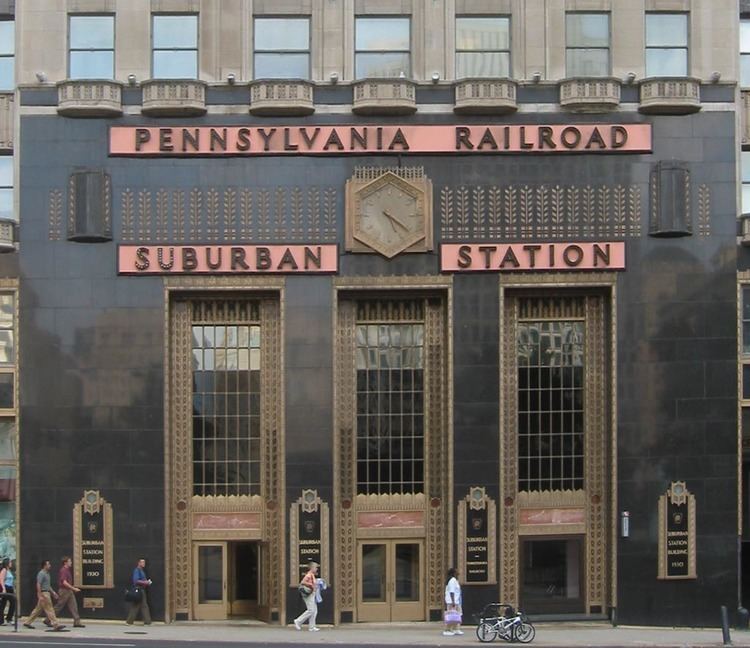Tracks 8 Phone +1 215-580-7800 | Opened 28 September 1930 | |
 | ||
Location 16th Street & JFK BoulevardPhiladelphia, Pennsylvania Line(s) Keystone Corridor (Main Line) Airport Line Chestnut Hill East Line Chestnut Hill West Line Cynwyd Line Fox Chase Line Lansdale/Doylestown Line Manayunk/Norristown Line Media/Elwyn Line Paoli/Thorndale Line Trenton Line Warminster Line West Trenton Line Wilmington/Newark Line Connections Broad Street Line at City Hall Market–Frankford Line at 15th Street SEPTA Trolley All Routes SEPTA City Bus: 2, 4, 16, 17, 27, 31, 32, 33, 38, 44, 48, 62 SEPTA Suburban Bus: 124, 125 Architecture firm Graham, Anderson, Probst & White Similar Jefferson Station, 30th Street Station, Temple University station, Fern Rock Transportation Center, Trenton Transit Center | ||
Suburban Station is an art deco office building and underground commuter rail station in Penn Center, Philadelphia. Its official SEPTA address is 16th Street and JFK Boulevard. The station is owned and operated by SEPTA and is one of the three core Center City stations on the SEPTA Regional Rail. The station was built by the Pennsylvania Railroad to replace the original Broad Street Station and opened on September 28, 1930.
Contents
Philadelphia s suburban station
History
The station opened as a stub-end terminal for Pennsylvania Railroad trains serving Center City Philadelphia, intended to replace the above-ground Broad Street Station in this function. The station's full name was originally Broad Street Suburban Station. One Penn Center served as the headquarters of the PRR from 1930 to 1957.
When Amtrak took over the Silverliner Service from Penn Central in 1972, it was operated as a quasi-commuter service that terminated at Suburban Station. The trains were named Keystone Service in 1981. By the late 1980s, the Metroliners used for the service were in poor shape, but Amtrak had a shortage of AEM-7 locomotives due to wrecks. On February 1, 1988, Amtrak converted all Keystone Service trains to diesel power and terminated them on the lower level of 30th Street Station, as diesel-powered trains were not allowed in the tunnels to Suburban Station. The change was listed as "temporary" on timetables starting on May 15, 1988 and lasting into 1990.
Plans for a tunnel to link the Pennsylvania and Reading commuter lines were floated as early as the 1950s, but funding to seriously study the project did not start until the late 1960s. The project languished in the 1970s due to lack of funding until federal money was appropriated during Philadelphia mayor Frank Rizzo's time in office.
Suburban Station was originally a stub-end terminal station with 8 tracks and 4 platforms until 1984 when the Center City Commuter Connection project extended four of those tracks eastward to the new Market East Station (now Jefferson Station), widened two of the existing platforms, realigned the tracks and added a fifth platform. The recently renovated 21-story building above is also the core of the Penn Center office complex, and is known as One Penn Center at Suburban Station. The office building attained an Energy Star Rating in 2009.
BLT Architects transformed Suburban Station in 2006. The station was redesigned to make navigation easier and adapt to current pedestrian traffic. Upgrades included increased retail space, a reactivated and improved HVAC system, and a restored/refurbished waiting area. The station is now in full compliance with the Americans with Disabilities Act of 1990. The Comcast Center, situated on the north half of its block near Arch Street, adds a "winter garden" on the south side, which serves as a new back entrance to the station, with the commuter rail tracks about 50 feet below street level.
Services
All SEPTA Regional Rail trains stop at this station. All run through except those on the Cynwyd Line as well as some limited/express trains which terminate on one of the stub-end tracks at this station. Through trains usually change crews at this station.
The station has an extensive concourse level above track level. This concourse has SEPTA ticket offices, retail shops and restaurants, and access to other SEPTA stations and to several Center City buildings. The connections include the Broad Street Line at the City Hall station and the Market-Frankford Line and Subway-Surface Lines at the 15th Street station.
